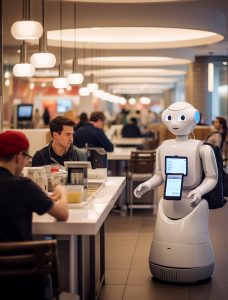By Inken Kuhlmann-Rhinow, EMEA Marketing Director, HubSpot
Technology has always had an impact on our society and economy, from the moment we traded hunting and gathering for agriculture. For a long time, technological developments followed at a moderate pace until the industrial revolution, but the digital revolution has seen the pace pick up even more.
A century ago it took five days to travel to America; now you’re there in a few hours. In the ’90s it was perfectly normal to wait a minute before a web page finally loaded. Nowadays, we are frustrated when it takes longer than a few seconds—waiting a week for your order? Ordered in the morning, delivered in the evening!
We talk about ‘disruptors’ as changing the face of business, and all too often the focus is on technology. ‘Disruptors’ are often delivering an innovative product based on new tech, or integrating old products with new technology-led platforms and services.
But ultimately, speed and ease of use are the common denominators. We have slowly lost the ability to wait, and increasing digitisation has only made that worse. What this creates is an ‘instant economy’. Consumers want to consume, not to wait. This economy is partly driven by online ‘disruptors’, and the impact on other businesses can be significant.
The COVID-19 pandemic has accelerated this development. Physical interaction, seamless delivery and quick service have all become necessities with little room for debate rather than just the preference for many customers. This makes the customer experience more critical than ever. Technology ‘disruptors’ have like Amazon, Spotify, Netflix, and Airbnb have also become experience leaders. In order to continue to compete with these giants, businesses must look beyond what they sell. To be able to face big tech, they need to focus on providing an unrivalled customer experience. In other words, they must learn to think like an ‘experience disruptor’.
How to think like an experience disruptor
If you analyse the business operations of experience disruptors, you can identify several factors that distinguish them from their competitors. By understanding these, you’ll get a better picture of your customers’ expectations, allowing you to take your own customer journey to the next level.
- Your product isn’t the holy grail: Of course, it’s important that you sell a reliable product, but it shouldn’t stop there. Your product/market fit is less important than your experience/market fit. You can have an incredibly strong product, but if the customer journey around it is not right, you will never achieve maximum success. Experience disruptors don’t just offer a product. They take away frustrations and offer experiences that consumers hadn’t even thought of.
- Reduce friction wherever you can: In every customer journey, there are moments when friction occurs. For example, huge amounts of information have to be filled in, there is a long wait, or it is unnecessarily complicated. Experience disruptors are experts in reducing friction. That, for example, is the mission of digital banks like Monzo and Starling. Their features are aimed at automating actions and eliminating thresholds. No paperwork is required to open an account; they integrate well with other digital platforms such as Siri and the app stores, and offer options such as automatic saving.
- Personalisation is everything: Why is it so nice to use Spotify? Because everything is focused on a personalised experience. The more you use their services, the better Spotify understands what you like, so you’ll get more and more outstanding recommendations. Your customers cannot be reduced to invoice numbers, so don’t segment them into generic buyer personas but focus on use cases. Continue to treat them as persons and use all the data at your disposal to deliver relevant experiences.
- Sell through your customers, not just to them: Your existing customer base is your best sales channel. Experience disruptors know this. They successfully use the top experiences they offer to promote brand advocacy. You don’t need complicated referral programs to do that. It can be something as simple as encouraging your audience to create content for your brand and share it on social media. In fact, you don’t even have to be a disruptor for that matter. Think of Coca-Cola, a beloved and one of the strongest brands out there, although not a disruptor in any way. However, it’s well known #shareacoke campaign has been hugely successful for years!
- The sale is just the beginning: The customer journey on the road to sales is essential, but what happens next is where an experience disruptor really shows its strength. Everyone’s probably heard it: “There’s really nothing I can do for you” or “No, I can’t take this back.” Deadly for the customer experience! Make sure that your staff is able to solve problems. Maybe it’s time to take a closer look at your terms and conditions. At any rate, ‘we can’t make it more fun’ is a thing of the past. ‘Everything for a smile’ is the future.
Becoming an experience disruptor is all about putting the customer experience at the heart of every business decision. Do you want to survive in the world of experience disruptors, or do you want to thrive? Then don’t ask yourself what your customers can do for you, but what you can do for your customers.
About the author

Inken Kuhlmann-Rhinow is the EMEA Marketing Director at HubSpot, the Marketing Software pioneer.
Related Articles

Chargeback Crisis: How Much are Subscription Services Losing?
Chargebacks, once a minor inconvenience for businesses, have evolved into a billion-dollar problem, hitting subscription-based services particularly hard.

How Retail Brands Are Elevating the Customer Journey with Technology, Personalization and Affiliate Marketing
A report by McKinsey found 60-70% of consumers participate in omnichannel shopping by using multiple channels during their shopping journey, underscoring the need for seamless transitions between them.

Beyond the Hype: Ensuring Online Pharma Safety Amid the GLP-1 Gold Rush
The booming weight loss drug market presents opportunities for manufacturers and retailers but also risks exploitation, including counterfeit and dangerous products, reminiscent of past health trends.

Robotics in Retail: Installations, Customer Service, and More
One of the most prominent and significant tech developments in the retail industry is the introduction of robotics. Today, not only are robots spotted in-store, but many companies are also employing robotic help for back-end processes like delivery fulfillment and storage automation.



 for the latest news and job opportunities in retail tech
for the latest news and job opportunities in retail tech 